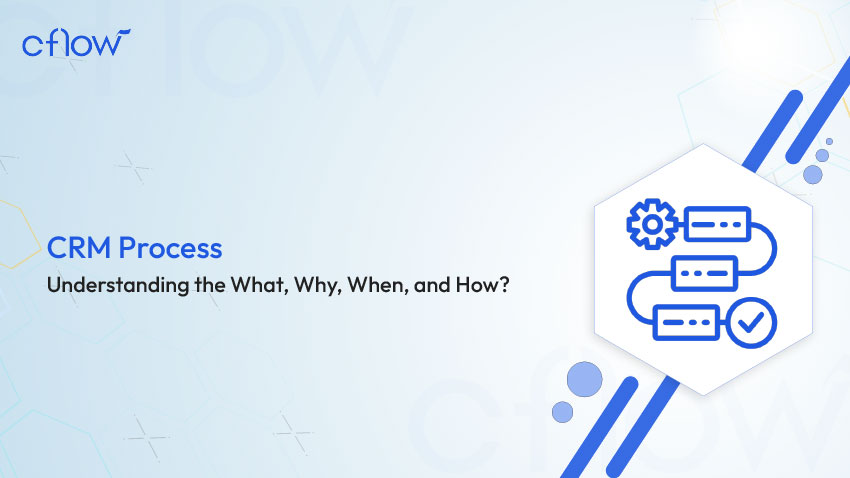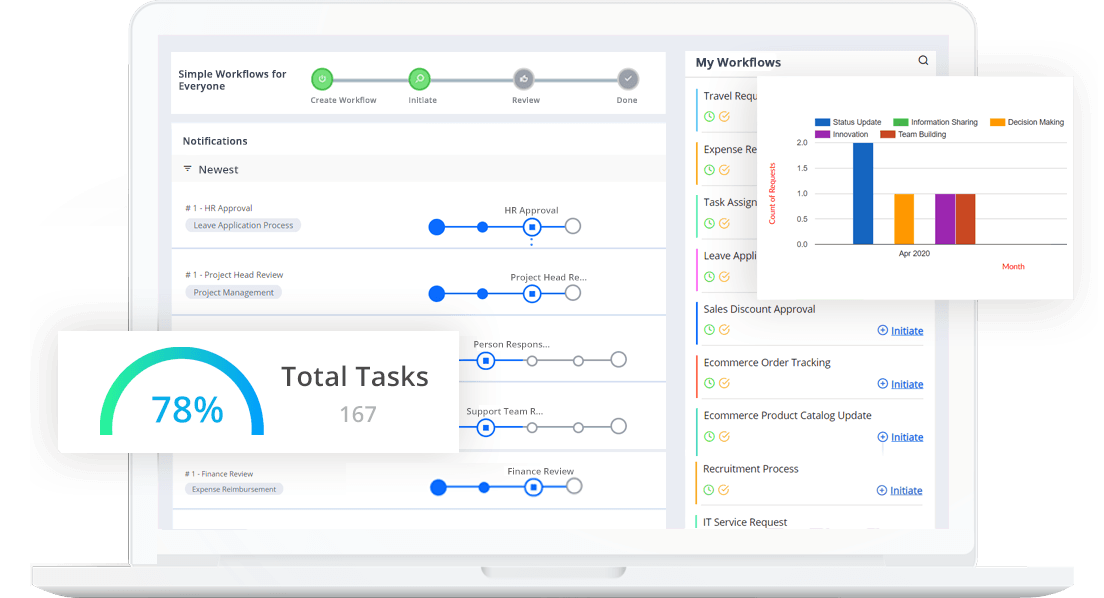Understanding the What, Why, When, and How of the CRM Process

Key takeaways
- The CRM process is a structured approach that helps businesses manage interactions with current and potential customers effectively.
- By integrating a CRM system process, companies can streamline customer relationships, improve sales cycles, and optimize marketing efforts.
- The CRM processes involve data collection, automation, analysis, and customer engagement, allowing businesses to personalize interactions and drive customer satisfaction.
- Implementing a CRM process enhances efficiency, improves collaboration between teams, and provides valuable insights into customer behavior.
- Organizations that adopt a well-defined CRM implementation process can increase customer loyalty, boost revenue, and enhance overall business performance.
What is CRM Process?
The CRM process refers to a systematic approach that businesses use to manage and analyze customer interactions throughout the customer lifecycle. It involves collecting and organizing customer data, automating communication and workflow processes, and ensuring personalized engagement with customers. The goal of CRM processes is to improve customer relationships, enhance customer retention, and ultimately drive sales growth.
A well-defined CRM system process enables businesses to streamline operations by centralizing customer information in one platform. Companies can track customer interactions, manage sales pipelines, and automate repetitive tasks, leading to improved efficiency and productivity. With the right CRM implementation process, businesses can also gain valuable insights into customer behavior, allowing them to refine marketing strategies and personalize customer experiences.
CRM processes are essential for businesses of all sizes as they help organizations stay competitive and build lasting customer relationships. Understanding the importance of CRM and its integration with customer service systems will help businesses optimize their customer relationship strategies and drive long-term success. This blog will explore the CRM process in detail, including its functionalities, benefits, key steps, and different types of CRM.
Table of Contents
The CRM Process in Detail
The CRM process involves several key functionalities that enable businesses to build strong customer relationships. The first step in the CRM system process is data collection, where businesses gather information from various customer touchpoints, including website interactions, social media, emails, and phone calls. This data is then stored in a centralized system, ensuring that all customer information is easily accessible for sales and marketing teams.
Once data collection is complete, CRM processes include automation of routine tasks such as email marketing, follow-ups, and appointment scheduling. Automation not only saves time but also ensures that no leads or customer queries are overlooked. The CRM process also facilitates lead tracking, allowing businesses to monitor potential customers’ progress through the sales funnel and identify opportunities for engagement.
Another crucial aspect of the CRM implementation process is customer segmentation. Businesses categorize customers based on demographics, purchase history, and behavior patterns. This segmentation helps in targeting the right audience with personalized offers and recommendations. Additionally, CRM enables real-time reporting and analytics, allowing organizations to measure sales performance, customer engagement, and marketing campaign effectiveness.
Why Do You Need a CRM Process?
A CRM process is essential for businesses looking to optimize customer interactions and improve efficiency. One of the primary reasons for implementing a CRM system process is enhanced customer relationship management. By maintaining a structured database of customer interactions, businesses can personalize engagement, address customer needs proactively, and build stronger relationships.
Another critical reason for adopting CRM processes is improved sales and marketing alignment. A CRM implementation process ensures that sales and marketing teams work collaboratively by providing them with shared access to customer data and insights. This leads to better lead generation, higher conversion rates, and more effective marketing campaigns.
Furthermore, CRM processes contribute to operational efficiency by automating routine tasks and streamlining workflows. Businesses can reduce manual efforts, minimize errors, and enhance productivity. Additionally, a well-implemented CRM system process enables better decision-making by offering data-driven insights into customer preferences, buying patterns, and overall market trends.
5 Important Steps in the CRM Process
1. Data Collection and Organization:
The first step in the CRM process is gathering customer data from multiple sources, including websites, social media, phone calls, and emails. This data is then stored in a centralized CRM system, making it easily accessible for sales, marketing, and customer service teams. Organizing data systematically helps businesses understand customer preferences and behaviors, allowing for more personalized interactions.
2. Customer Segmentation:
Once customer data is collected, businesses must categorize customers based on factors such as demographics, purchasing behavior, and engagement history. Segmentation helps businesses target the right audience with relevant marketing messages and offers. It also enables sales teams to prioritize leads effectively and focus on high-potential prospects.
3. Automation and Workflow Management:
CRM processes involve automating routine tasks such as sending follow-up emails, scheduling meetings, and tracking customer interactions. Automation minimizes manual work, reduces errors, and ensures timely customer engagement. Workflow management within CRM ensures that teams collaborate efficiently and no critical customer interactions are missed.
4. Customer Interaction and Relationship Management:
Engaging with customers through personalized communication is a vital part of the CRM process. Businesses can leverage CRM tools to send customized emails, provide real-time support, and offer tailored product recommendations. Maintaining consistent and meaningful interactions strengthens customer relationships and fosters brand loyalty.
5. Performance Tracking and Analytics:
A key aspect of the CRM implementation process is analyzing performance metrics. CRM software provides detailed insights into sales performance, marketing campaign effectiveness, and customer engagement levels. By monitoring these metrics, businesses can make data-driven decisions, identify improvement areas, and refine their CRM strategies.
When Do You Need a CRM Process?
Businesses need a CRM process when managing customer relationships becomes complex and time-consuming. As a company grows, handling interactions manually across multiple platforms can lead to inefficiencies, missed opportunities, and lost leads. A CRM system ensures that customer data is centralized, helping teams maintain organized, structured, and actionable insights.
Another indication that a business requires a CRM system is declining customer retention. If customer loyalty is diminishing, implementing a CRM process can help track interactions, personalize engagement, and build stronger relationships. For instance, a retail business experiencing a drop in repeat purchases can use CRM analytics to identify disengaged customers and create targeted promotions to re-engage them.
A business also needs a CRM system when sales and marketing teams lack coordination. Without a centralized platform, valuable leads can get lost, and marketing efforts may not align with sales objectives. Implementing a CRM ensures seamless communication, allowing sales representatives to track customer journeys and enabling marketers to fine-tune strategies based on real-time data.
Additionally, businesses that struggle with data management and analysis can greatly benefit from a CRM system. If customer data is scattered across spreadsheets, emails, and individual records, extracting meaningful insights becomes difficult. A CRM system consolidates all interactions, making it easier to track customer behavior, forecast sales, and measure campaign effectiveness.
Key CRM Statistics
92% of businesses acknowledge the role of CRM software in achieving their revenue goals.
CRM market insights reveal that the Global CRM market is poised to reach a whopping $80 billion by 2025.
Less than 40% of CRMs have full scale adoption in a company. Adoption is often curtailed by ineffective change management and enablement.
How to Implement a CRM Process?
Implementing a CRM process requires careful planning, evaluation, and execution to ensure that the system aligns with business goals. The first step is identifying the specific needs of the organization. Businesses should assess pain points, such as poor customer retention, inefficient sales tracking, or lack of automation, and define objectives that the CRM system should address.
Once business needs are determined, the next step is selecting the right CRM workflow software. There are various CRM solutions available, each catering to different business sizes and industries. Factors to consider include ease of use, scalability, integration capabilities, and automation features. A small business may require a user-friendly CRM with essential lead management features, while an enterprise might need a comprehensive solution with advanced analytics and AI-driven insights.
The third step is data migration. Transitioning from manual records or legacy systems to a CRM platform requires proper planning to avoid data loss or inconsistencies. Businesses should clean and organize existing customer data before transferring it to the new system. Proper mapping of customer profiles, transaction history, and interactions ensures a smooth transition.
After data migration, employee training is crucial. Employees must understand how to navigate the CRM system, update customer records, and utilize automation features effectively. Conducting training sessions, providing user guides, and offering continuous support helps teams maximize the CRM’s potential and integrate it seamlessly into daily operations.
Next, businesses should define workflows and automation rules. A CRM system streamlines customer interactions through automated follow-ups, email sequences, and reminders. Establishing workflows ensures that leads are nurtured systematically, support tickets are addressed promptly, and sales pipelines are optimized.
Finally, ongoing evaluation and optimization are essential for CRM success. Businesses should regularly analyze CRM reports to measure performance, track user adoption, and identify areas for improvement. Feedback from employees and customers can guide adjustments, ensuring that the CRM system evolves with the organization’s needs.
4 Pillars of CRM
Strategy:
A well-defined CRM strategy outlines how a business plans to acquire, engage, and retain customers. This includes setting customer engagement goals, defining target audiences, and developing tailored marketing campaigns. A strong strategy aligns CRM objectives with overall business goals, ensuring consistency in customer interactions and service delivery.
People:
Employees play a crucial role in CRM success, as they interact directly with customers and use CRM tools for engagement. Organizations must train employees on CRM systems, best practices, and customer service skills to maximize the effectiveness of CRM implementation. A customer-centric approach across all departments ensures that every interaction is meaningful and adds value to customer relationships.
Technology:
The CRM system process relies on technology to manage customer data, automate workflows, and enhance customer experiences. Modern CRM platforms offer features such as artificial intelligence, data analytics, and cloud-based access, enabling businesses to make data-driven decisions and improve efficiency. Choosing the right CRM technology is critical to ensuring seamless integration and usability.
Processes:
CRM processes ensure that workflows are standardized, customer interactions are streamlined, and data is effectively utilized. A structured CRM framework allows businesses to track customer journeys, automate repetitive tasks, and measure engagement levels. Well-defined processes help organizations maintain consistency in service delivery and improve overall customer satisfaction.
Types of CRM
- Operational CRM: Focuses on automating sales, marketing, and customer service operations. It includes functionalities like lead management, contact tracking, and email automation, enabling businesses to streamline customer interactions and improve response times.
- Analytical CRM: Provides data-driven insights into customer behavior and sales performance. By leveraging predictive analytics and trend analysis, businesses can identify high-value customers, optimize marketing efforts, and make strategic decisions that drive revenue growth.
- Collaborative CRM: Enhances teamwork by ensuring seamless communication between departments. It facilitates information sharing between sales, marketing, and support teams, enabling a unified approach to customer relationship management and improving cross-functional collaboration.
CRM and Customer Service Systems – Compare and Contrast
CRM systems and customer service systems are closely related but serve different purposes. While CRM processes focus on managing customer interactions, customer service systems are designed to resolve customer issues efficiently. CRM enables businesses to track and nurture customer relationships over time, whereas customer service systems provide real-time support and problem resolution.
A CRM system primarily helps businesses manage and analyze customer interactions throughout the customer lifecycle. It centralizes customer data, automates workflows, and provides valuable insights that improve sales and marketing efforts. For example, a retail company using a CRM system can track customer purchase history, send personalized promotions, and automate follow-up communications to enhance engagement. This proactive approach helps businesses nurture leads and retain customers.
On the other hand, customer service systems focus on resolving customer issues in a timely and efficient manner. These systems include help desk software, chatbots, and call center platforms that assist customer service representatives in addressing customer concerns. For instance, a telecommunications company may use a customer service system to manage incoming support tickets, assign cases to relevant agents, and provide customers with self-service options like FAQs and knowledge bases.
Although CRM and customer service systems operate differently, they are complementary. A well-integrated CRM and customer service system ensures a seamless customer experience. For example, if a support agent has access to a customer’s previous interactions and purchase history stored in the CRM, they can provide more personalized and efficient assistance. This integration eliminates redundant communication, improves customer satisfaction, and strengthens long-term relationships.
Another key difference lies in their primary users. CRM systems are typically utilized by sales and marketing teams to track leads, optimize sales funnels, and manage customer engagement strategies. In contrast, customer service systems are used by support teams that handle inquiries, complaints, and technical issues. However, businesses that integrate both systems can achieve a more holistic approach to customer relationship management, leading to higher customer retention and operational efficiency.
In summary, while CRM systems focus on relationship building, lead nurturing, and long-term customer engagement, customer service systems prioritize immediate issue resolution and support. Businesses that integrate these systems can create a seamless experience that enhances customer satisfaction, streamlines operations, and drives growth.
End-to-end workflow automation
Build fully-customizable, no code process workflows in a jiffy.
Benefits of CRM Process
Improved Customer Relationships:
CRM systems enable businesses to build and maintain strong customer relationships by keeping track of all customer interactions. With a centralized database, companies can personalize communication, respond to inquiries promptly, and proactively address customer needs.
This leads to increased trust, brand loyalty, and long-term customer engagement. For example, an e-commerce company can use CRM to track purchase history and offer tailored product recommendations.
Increased Sales and Revenue:
A well-implemented CRM system streamlines the sales process by automating lead tracking, follow-ups, and conversion management. By organizing customer data and providing sales teams with real-time insights, businesses can identify high-potential leads, nurture prospects effectively, and close deals faster. A real estate firm, for instance, can use CRM to track client interactions and set reminders for timely follow-ups, leading to more successful sales.
Enhanced Marketing Effectiveness:
CRM allows businesses to segment their customers based on demographics, behaviors, and purchase history, enabling more targeted and personalized marketing campaigns. By analyzing customer data, businesses can optimize their advertising strategies, increase conversion rates, and maximize marketing ROI. A fashion brand, for example, can leverage CRM to send personalized promotions to frequent shoppers, boosting engagement and repeat purchases.
Streamlined Workflows and Automation:
CRM automates repetitive tasks such as data entry, email marketing, and follow-ups, reducing manual workload and improving efficiency. It ensures smooth coordination between departments by enabling seamless information sharing. A healthcare provider can automate appointment scheduling and patient follow-ups, ensuring timely engagement and improved patient care.
Better Decision-Making with Data-Driven Insights:
CRM systems provide businesses with valuable analytics and reporting tools that help in making informed decisions. With insights into customer behaviors, sales trends, and service performance, businesses can refine their strategies and optimize operations. For example, a SaaS company can analyze CRM reports to determine customer churn rates and take proactive measures to improve retention.
By leveraging the benefits of CRM, businesses can enhance customer satisfaction, drive profitability, and maintain a competitive edge in the market.
Final Thoughts
A well-structured CRM process is crucial for businesses aiming to enhance customer relationships, boost sales, and improve operational efficiency. Implementing a CRM system process helps businesses automate workflows, optimize marketing strategies, and gain valuable insights into customer behavior. To streamline CRM processes, organizations can leverage AI-powered workflow solutions like Cflow. By integrating automation and data analytics, Cflow enhances CRM efficiency, ensuring businesses stay competitive in a rapidly evolving market.
FAQs
- What is a CRM process?
A CRM process is a structured approach businesses use to manage customer relationships, automate workflows, and optimize sales and marketing strategies.
- How does a CRM system process improve customer engagement?
CRM enables personalized communication, targeted marketing, and automated follow-ups, ensuring better customer interactions and retention.
- What are the key steps in the CRM implementation process?
The key steps include data collection, segmentation, automation, customer engagement, and performance tracking.
- What are the different types of CRM?
The main types are operational CRM, analytical CRM, and collaborative CRM, each catering to different business needs.
- Why is automation important in CRM processes?
Automation reduces manual effort, minimizes errors, enhances efficiency, and ensures timely customer interactions.
- How does CRM contribute to business growth?
CRM streamlines operations, improves customer retention, and boosts revenue by enhancing sales and marketing efforts.
What should you do next?
Thanks for reading till the end. Here are 3 ways we can help you automate your business:

Do better workflow automation with Cflow
Create workflows with multiple steps, parallel reviewals. auto approvals, public forms, etc. to save time and cost.

Talk to a workflow expert
Get a 30-min. free consultation with our Workflow expert to optimize your daily tasks.

Get smarter with our workflow resources
Explore our workflow automation blogs, ebooks, and other resources to master workflow automation.
What would you like to do next?
Automate your workflows with our Cflow experts.



